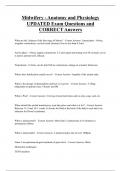Midwifery - Anatomy and Physiology
UPDATED Exam Questions and
CORRECT Answers
What are the 3 phases of the first stage of labour? - Correct Answer- Latent phase - 0-4cm,
irregular contractions, cervical canal shortens (3cm to less than 0.5cm).
Active phase - 4-8cm, regular contractions 2-5 mins apart and lasting over 60 seconds, cervix
is mid to anterior/soft, effaced.
Transitional - 8-10cm, can be brief lull in contractions, change in woman's behaviour.
Where does fertilisation usually occur? - Correct Answer- Ampulla of the uterine tube.
What is the dosage of diamorphine and how is it given? - Correct Answer- 5-10mg
(dependent on patient size), 4 hourly and IM.
What is Pica? - Correct Answer- Craving of non-food items such as clay, soap, coal, etc.
When should the nuchal translucency scan take place and what is it for? - Correct Answer-
Between 11+2 and 14+1 weeks. It checks the fluid at the back of the baby's neck and is an
indicator for Down's syndrome.
What is tachysystole? - Correct Answer- More than 5 contractions in 10 minutes in
spontaneous labour.
What is tachycardia? - Correct Answer- A maternal pulse rate of over 100bpm.
Name 5 non-pharmacological methods of pain relief. - Correct Answer- Water
Distraction techniques
TENS machine
,Position
Massage
Hypnotherapy
Aromatherapy
Acupuncture
Breathing techniques
What changes occur in the maternal respiratory system during pregnancy? - Correct Answer-
Oxygen consumption increases by up to 20-30%
Rib cage expands
Tidal volume increases by up to 30-40%
Name 3 types of abnormal placenta. - Correct Answer- Battledore insertion - cord inserted on
the edge
Velementous insertion - cord inserted through the membranes, some distance from the
placenta
Succenturiate lobe - a lobe which is separated from the main body but connected by the
placental blood vessels
Circumuallate - opaque ring
Bipartite - two separate lobes and a bifurcated cord
The zygote undergoes mitotic cellular division (clevage), resulting in the formation of smaller
cells. What is the zygote called at each of these changes (day 1, day 3 and day 4)? - Correct
Answer- Day 1 - blastomere
Day 3 - morula
, Day 4 - blastocyst
There are 3 primary germ layers that are the main embryonic tissues, from which structures
and organs develop. What are they and what develops from them? - Correct Answer-
Ectoderm - epidermis layer of skin, hair, nails and the nervous system
Mesoderm - muscle, skeleton, dermis of skin, connective tissue, urogenital gland, blood
vessels, blood and lymph cells
Endoderm - epithelial lining of the digestive, respiratory and urinary systems and glandular
organs, such as the liver and the pancreas
What is the dosage of meptid and how should it be given? - Correct Answer- 75-150mg, 2-4
hourly and IM.
What is haemoglobin broken down into? - Correct Answer- Iron - which produces more red
blood cells
Globin - a protein used in the body
Un-conjugated bilirubin - toxic, fat-soluble, not easily excreted in bile/urine, causes yellow
discolouration of skin and deposits in the brain
Sensory receptors that respond to pain are called? - Correct Answer- Nocioceptors
What should you look for when performing a vaginal examination. - Correct Answer- Labia -
varicosities, oedema, warts, sores, etc
Perineum - scars, epis, FGM, etc
Vaginal orifice - discharge, show, liquor, bleeding etc




